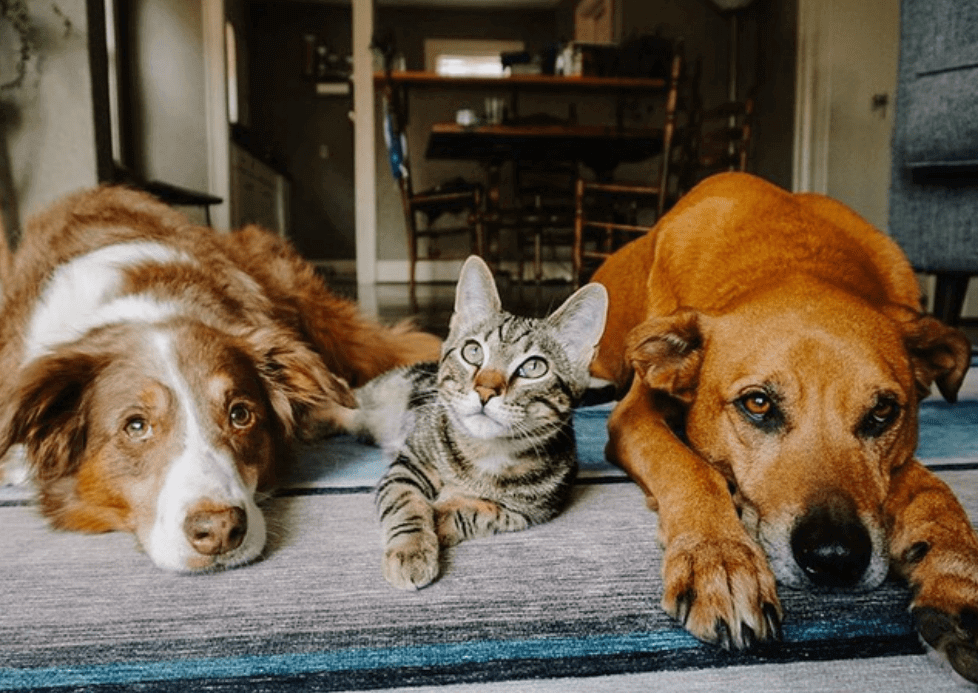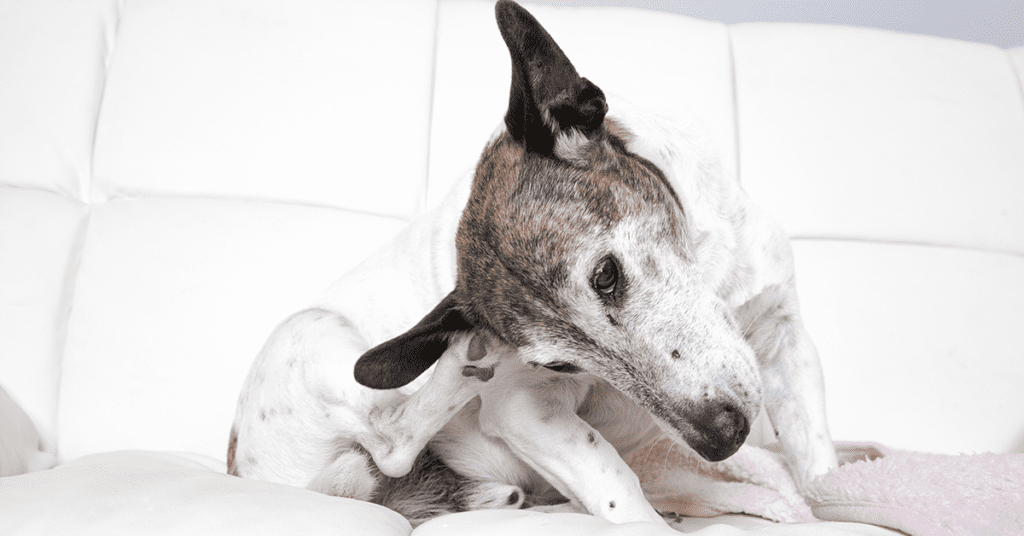
Even the best pet parent can miss signs that might mean your dog or cat is dealing with food allergies or sensitivities. The good news is, we can help you spot some of the potential signs and specific ingredients to look for in your pet’s food that could be the culprit.

Food sensitivities can often be confused with food allergies and vice versa. While a food allergy is caused by an immune system response, a food sensitivity is caused by a digestive system response. A food sensitivity is also commonly called a food intolerance. An example of a food sensitivity/intolerance in humans would be lactose intolerance. Those suffering from this intolerance do not naturally create the enzyme necessary to digest lactose. Similar situations can arise for pets, although from different ingredients.
Food sensitivities in pets are more common than a food allergy. Suffering from food sensitivities can be very uncomfortable for your pet and very inconvenient for you, so it is worth it to find the cause and avoid any ingredient or food type that your pet may be sensitive to. Food sensitivities, like food allergies, can develop during any stage of life. It’s also important to note that while food allergies can be life threatening, food sensitivities are not. You’ll still of course want to deal with any food sensitivity you can in order to give you and your fur baby the best life possible.
Some of the more common pet food ingredients that cause sensitivities include:
-Food additives, including artificial flavors, preservatives, and food dyes
-Wheat/gluten
-Dairy
-Chicken or other poultry
-Beef
-Soy
-Corn
Cat & Dog Food Sensitivity/Intolerance Symptoms
1. Gas and/or noisy stomach:
If your pet is struggling with constant gas or you always hear their tummy rumbling, it is possible that the root of this problem may be due to a food sensitivity.
2. Diarrhea, irregular stool, or painful bowel movements:
If your pet is experiencing routine bouts of diarrhea, inconsistent stools, or straining to defecate, this could be a sign of a food intolerance. We recommend consulting with your veterinarian if any of this happens as it could be indicative of a variety of other serious medical issues as well.
3. Vomiting:
While vomiting may happen occasionally for your pet, having it happen regularly is a definite sign that something is wrong. Frequent vomiting, especially after mealtime, is a common symptom of a food intolerance but can also stem from other issues so be sure to contact your veterinarian.
4. Changes in energy:
If you notice that your pet’s energy level has drastically changed, it could possibly be caused by a food sensitivity.
5. Itchy skin, ears, and skin rashes:
While these are also common signs of a food allergy, they can also be linked to a food sensitivity.
6. Loss of appetite/lack of interest in food:
While some pets can be a bit particular about their food, a lack of interest in meals could also be a sign of a food sensitivity. Your pet may begin to associate food with being uncomfortable when they are dealing with a food sensitivity.
Determining whether or not your pet does have a food intolerance will take a vet visit, along with some time. A diet change avoiding the ingredient or food type will be the corrective course of action. As our diets are minimally processed, contain high-quality ingredients, and are available in a variety of recipes with different proteins, our food can often be a great solution for those pets that are dealing with food sensitivities. Additives used in foods can also be the cause of many food sensitivities –our food is always free of artificial colors, preservatives, and flavors and never contains added hormones or antibiotics. Our Freeze-Dried Raw Dinner Patties for Dogs and Freeze-Dried Raw Morsels for Cats have many single source animal protein recipes that also contain limited overall ingredients that pets with food sensitivities tend to thrive on.
Similarly to food allergies, some breeds may be predisposed to certain food sensitivities. That said, feeding variety can help. While you do not want to be constantly switching food types, as quick changes can cause digestive issues, you can switch up recipes/proteins within the same food group. Once your dog or cat is fully transitioned to our food, we do suggest rotating proteins every 2-6 weeks. This means you would feed one flavor consistently for 2-6 weeks, then switch to another flavor for 2-6 weeks, etc. This is a great way to give your dog variety and to help keep protein-based allergies and food sensitivities at bay. Probiotics are also a great tool when dealing with digestive upset or irregularity. All of our raw diets and baked kibble recipes contain added probiotics for optimal digestion. We also offer Stella’s Solutions Digestive Boost for Dogs and Stella’s Solutions Digestive Boost for Cats – freeze-dried raw morsels that can be fed as a complete meal or used as a topper to the current diet for an added boost.

Allergies are caused by an immune system response to a foreign substance that it mistakenly categorizes as harmful or dangerous. While allergies are often associated with people, dogs and cats can also have allergies, especially when it comes to food. Here are some signs that your dog or cat may be dealing with a food allergy and how to help.
Cat & Dog Food Allergy Symptoms
1. Excessive itching and scratching:
Dogs and cats suffering from food allergies will often scratch excessively as the allergy will often manifest via the dog or cat’s skin. This will be markedly different from the occasional scratch here or there as your dog or cat will be incredibly uncomfortable. This itching could result in your pet rolling over onto their back more and rubbing against the ground or other surfaces, in addition to using their legs to scratch themselves.
2. Constantly licking paws:
Similar to scratching, this will be a marked difference from your pet’s normal behavior. It could manifest itself in your pet’s paws will likely be red and inflamed.
3. Skin and fur inconsistencies:
Fur and skin is incredibly telling when it comes to an animal’s health. Hot spots, dry/flaky skin, red skin, scabs and a drastic change in coat could be additional signs that your pet is dealing with an allergy. While a dulling or poor coat may or may not mean allergies, it could mean that a better food provides more of the nutrients your dog or cat needs to thrive and look his or her best.
4. Chronic ear infections:
As a result of consuming an allergen, yeast can build up and cause a continuous stream of ear infections.
5. Watery eyes and tear stains:
While often seen as commonplace, tear stains are usually tied back to diet and can worsen as part of an allergic reaction.
6. Other changes in behavior:
If your dog or cat seems off or acting different what you’re feeding them, whether it is a food allergy issue, could be the reason and changing their food may be the solution.
If you’re seeing your pet show the symptoms above, it’s time to schedule a vet appointment. Food allergies in pets are not only incredibly uncomfortable, but also can have serious negative long-term effects if left unaddressed. Your vet will ask for detailed information on what your pet has been eating, including both meals and treats, as this will be needed to help the vet determine next steps.
How to Discover the Specific Allergy
Food allergies are determined by a vet by a food elimination diet or a novel protein diet trial. These are non-invasive ways to test out whether or not your pet has a food allergy. This will consist of your vet suggesting a diet with proteins and ingredients that are new to your pet for a certain length of time. If the symptoms go away, the food allergy is confirmed. In order to isolate the exact allergen(s), ingredients will be reintroduced slowly to your dog’s diet to understand just what ingredient(s) is causing the allergic reaction.
Some of the more common pet food allergies include:
-Corn
-Wheat/gluten
-Dairy
-Chicken or other poultry
-Beef
-Egg
-Soy
Food Allergy Treatment
Once the allergen piece of the puzzle is solved, treatment is very to the point, as you will have to avoid feeding your pet that specific allergen. For some, this can be incredibly challenging as it’s possible for there to be a long list of allergens, making it much more difficult for the pet parent. In other cases, the allergen can be an incredibly common ingredient in pet food which can also provide a challenge for the pet parent to find something different that doesn’t include the ingredient.
Our food can often offer a great solution for pet parents dealing with pet allergies as our recipes contain fewer allergy triggering ingredients. All Stella & Chewy’s recipes are wheat-free, yeast-free, dairy-free and nut-free – all of which can be common allergens for dogs and cats. Our food also has natural oils and is minimally processed, which can aid pets dealing with skin issues as a result of allergies. Additionally, we have many single-source animal protein recipes across our product lines, which can make it a bit easier to avoid allergens. We even offer some more novel proteins in our raw diets, like Absolutely Rabbit, Venison Blend, Purely Pork, and Simply Venison that can be helpful for the novel protein diet trial.
Is there any way to avoid food allergies in pets?
According to WebMD, about 10% of all pet allergies are food allergies, with the other being environmental. Some breeds may be predisposed to certain food allergies. That said, feeding variety can help. While you do not want to be constantly switching food types, as quick changes can cause digestive issues, you can switch up recipes/proteins within the same food group. Once your dog or cat is fully transitioned to our food, we do suggest rotating proteins every 2-6 weeks. This means you would feed one flavor consistently for 2-6 weeks, then switch to another flavor for 2-6 weeks, etc. This is a great way to give your dog variety and to help keep protein-based allergies at bay.
What else can you be doing?
Consider a food that contains probiotics that can help strengthen the immune system. Your dog’s gastrointestinal system (mouth, stomach, intestines) protects them from potential allergens each day. Approximately 70 percent of the body’s entire immune system is centered in the gastrointestinal tract. Probiotics are a part of the majority of our recipes.
Our information comes from consultation with our food science experts and veterinarians. For each pet, we always recommend consulting with that pet’s veterinarian as they are most likely to know their particular needs.
GET $3 OFF, INSIDER OFFERS, AND HELPFUL PET CARE TIPS.
By entering your information, you are opting in to receive communication from Stella & Chewy's
